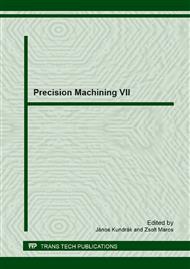[1]
A. Vanak. Technologie frézování. [online]. 2007: <http: /www. sossou-spk. cz/esf/TEC_fr. pdf - TEC_fr. pdf >.
Google Scholar
[2]
J. Duplak, I. Orlovsky, M. Cuma. Comprehensive expression of durability for the selected cutting tools in comparison with standard ISO 3685. In: Advanced Science Letters. Volume 19, Issue 2, February 2013, pp.460-463. ISSN: 19366612.
DOI: 10.1166/asl.2013.4745
Google Scholar
[3]
P. Hreha, S. Hloch. Potential use of vibration for metrology and detection of surface topography created by abrasive waterjet / Int. J. Surface Science and Engineering, Vol. 7, No. 2(2013), pp.135-151.
DOI: 10.1504/ijsurfse.2013.053699
Google Scholar
[4]
Z. Hutyrova, J. Zajac, A. Tarasovicova. Assessment of Statistical Signification of Factors by Machining Inhomogeneous Materials – WPC. In: Applied Mechanics and Materials. Vol. 308 (2013), pp.165-169. - ISSN 1662-7482.
DOI: 10.4028/www.scientific.net/amm.308.165
Google Scholar
[5]
J. Novak-Marcincin, M. Janak, L. Novakova-Marcincinova, V. Fecova, Possibility of quick check on milling strategy suitability, In: Tehnički Vjesnik, Vol. 19, no. 4 (2012), pp.959-964, ISSN 1330-3651.
DOI: 10.1063/1.4707641
Google Scholar
[6]
[online]. http: /www. conrad. de/medias/global/ce/1000_1999/1000/1040/1043/104369_RB_ 00_FB. EPS_1000. jpg.
Google Scholar
[7]
J. Madl, J. Kafka, M. Vrabec, R. Dvorak, Technologie obrábění – 1. Díl. České vysoké učení technické v Praze, Fakulta strojní. p.75.
DOI: 10.14311/bk.9788001071397
Google Scholar
[8]
A. Czan, M. Neslusan, Trieskové obrábanie ťažkoobrábateľných materiálov. 2005. p.156. ISBN 80-969395-2-1.
Google Scholar
[9]
K Vasilko, E. Ragan, Teória výrobných technológií. Technická univerzita v Košiciach, Fakulta výrobných technológií so sídlom v Prešove, Prešov, 2010, p.241, ISBN 978-80-553-0367.
DOI: 10.15584/eti.2018.3.48
Google Scholar
[10]
M. S. Shahrom, N. M. Yahya, A. R. Yusoff, Taguchi Method Approach on Effect of Lubrication Condition on Surface Roughness in Milling Operation, Procedia Engineering, vol. 53, 2013, pp.594-599, ISSN 1877-7058.
DOI: 10.1016/j.proeng.2013.02.076
Google Scholar
[11]
X. Cui, J. Zhao, Z. Pei, Analysis of transient average tool temperatures in face milling, International Communications in Heat and Mass Transfer, Vol. 39, 2012, pp.786-791, ISSN: 0735-(1933).
DOI: 10.1016/j.icheatmasstransfer.2012.05.009
Google Scholar


